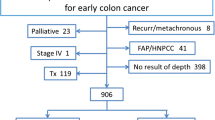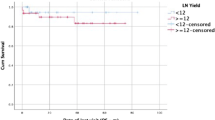Abstract
Some studies showed that the increase of tumor size has a negative effect on survival in colon cancers. Our study aims to assess the effects of tumor volume on lymph node positivity and prognosis in stage pT3 colon cancers. All patients who underwent surgery for colon cancer in our clinic were evaluated retrospectively. The study included 213 patients who were diagnosed with colon adenocarcinoma and reported as pathologic. Preoperative abdomen computed tomography scans were used for measurements of tumor volume. Tumor volumes were compared according to the pathological lymph node involvement. Cut-off values were determined with ROC analysis. The cases were divided into groups according to the determined cut-off value and data compared. Mean tumor volume was found to be higher in the lymph node-positive group (p=0.01). The higher number of removed lymph nodes and lymph node positivity was detected more in cases that were above the cut-off value (p=0.003 and p=0.004, respectively). The mean survival time was 37.3±1.3 months. There was no correlation between tumor volume and the overall survival time (p=0.21). According to data comparison of the lymph node positivity, Kaplan-Meier analysis showed that the increase of the N stage reduces the 5-year survival rate (for the N0, N1, N2 stages, 60%, 52%, 35%, respectively). Tumor volume is correlated with lymph node involvement. It has been shown that increasing the N stage has a negative effect on prognosis. Our study showed that tumor volume has no significant impact on survival but may have an indirect effect on prognosis.



Similar content being viewed by others
References
Jemal A, Bray F, Center MM, Ferlay J, Ward E, Forman D (2011) Global cancer statistics. CA Cancer J Clin 61:69–90
Brenner H, Kloor M, Pox CP (2014) Colorectal cancer. Lancet. 383:1490–1502
Edge SB, Compton CC (2010) The American Joint Committee on Cancer: the 7th edition of the AJCC cancer staging manual and the future of TNM. Ann Surg Oncol 17(6):1471–1474
Dukes CE (1932) The classification of cancer of the rectum. J Pathol Bacteriol 35:323–732
Ahmadi O, Stringer MD, Black MA, McCall JL (2015) Clinico-pathological factors influencing lymph node yield in colorectal cancer and impact on survival: analysis of New Zealand Cancer Registry data. J Surg Oncol 111(4):451–458
Lykke J et al (2019) Lymph node yield and tumor subsite are associated with survival in stage I–III colon cancer: results from a national cohort study. World J Surg Oncol 17.1:62
Saha S, Shaik M, Johnston G, Saha SK, Berbiglia L, Hicks M, Gernand J, Grewal S, Arora M, Wiese D (2015) Tumor size predicts long-term survival in colon cancer: an analysis of the National Cancer Data Base. Am J Surg 209(3):570–574
Wright FC, Law CHL, Last L, Khalifa M, Arnaout A, Naseer Z, Klar N, Gallinger S, Smith AJ (2003) Lymph node retrieval and assessment in stage II colorectal cancer: a population-based study. Ann Surg Oncol 10:903–909
Leibl S, Tsybrovsky O, Denk H (2003) How many lymph nodes are necessary to stage early and advanced adenocarcinoma of the sigmoid colon and upper rectum? Virchows Arch 443:133–138
Baxter NN, Virnig DJ, Rothenberger DA, Morris AM, Jessurun J, Virnig BA (2005) Lymph node evaluation in colorectal cancer patients. J Natl Cancer Inst 97:219–225
Morris EJ, Maughan NJ, Forman D et al (2007) Identifying stage III colorectal cancer patients: the influence of the patient, surgeon, and pathologist. J Clin Oncol 25:2573–2579
Willaert W, Mareel M, Van De Putte D et al (2014) Lymphatic spread, nodal count and the extent of lymphadenectomy in cancer of the colon. Cancer Treat Rev 40:405–413
Gonsalves WI, Kanuri S, Tashi T, Aldoss I, Sama A, al-Howaidi I, Ganta A, Kalaiah M, Thota R, Krishnamurthy J, Fang X, Townley P, Ganti AK, Subbiah S, Silberstein PT (2011) Clinicopathologic factors associated with lymph node retrieval in resectable colon cancer: a Veterans’ Affairs Central Cancer Registry (VACCR) database analysis. J Surg Oncol 104:667–671
Goldstein NS (2002) Lymph node recoveries from 2427 pT3 colorectal resection specimens spanning 45 years: recommendations for a minimum number of recovered lymph nodes based on predictive probabilities. Am J Surg Pathol 26:179–189
Paulson EC, Wirtalla C, Armstrong K, Mahmoud NN (2009) Gender influences treatment and survival in colorectal cancer surgery. Dis Colon Rectum 52:1982–1991
Edge SB, Byrd DR, Compton CC, Fritz AG, Greene FL, Trotti A (eds) (2010) AJCC (American Joint Committee on Cancer) Cancer Staging Manual. Springer, New York
Parsons HM, Tuttle TM, Kuntz KM, Begun JW, McGovern PM, Virnig BA (2011) Association between lymph node evaluation for colon cancer and node positivity over the past 20 years. JAMA 306:1089–1097
National Cancer Institute’s SEER database. http://seer.cancer.gov/. 26 August 2016, date last accessed
Beart RW, Steele GD, Menck HR et al (1995) Management and survival of patients with adenocarcinoma of the colon and rectum: a national survey of the Commission on Cancer. J Am Coll Surg 181:225–236
Acknowledgements
Thank you for the contribution of all authors.
Author information
Authors and Affiliations
Contributions
Study conception and design of study: M.S. and M.Ç. Acquisition of data: M.Ç., M.S., H.Ö., and M.A.Y. Analysis and interpretation of data: M.Ş., M.Ç., and A.Ç. Drafting of manuscript: M.Ç., M.S., H.Ö., M.A.Y., and A.Ç. Critical revision of manuscript: C.V., M.S., M.Ç., H.Ö., and M.A.Y. Final approval of the manuscript: C.V., M.S., and M.A.Y.
Corresponding author
Ethics declarations
Conflict of Interest
The authors declare no competing interests.
Additional information
Publisher’s Note
Springer Nature remains neutral with regard to jurisdictional claims in published maps and institutional affiliations.
Rights and permissions
About this article
Cite this article
Şentürk, M., Özer, H., Çelik, A. et al. Effects of Tumor Volume on Lymph Node Involvement and Prognosis at Stage pt3 Colon Cancers. Indian J Surg 84, 131–135 (2022). https://doi.org/10.1007/s12262-021-02859-2
Received:
Accepted:
Published:
Issue Date:
DOI: https://doi.org/10.1007/s12262-021-02859-2




